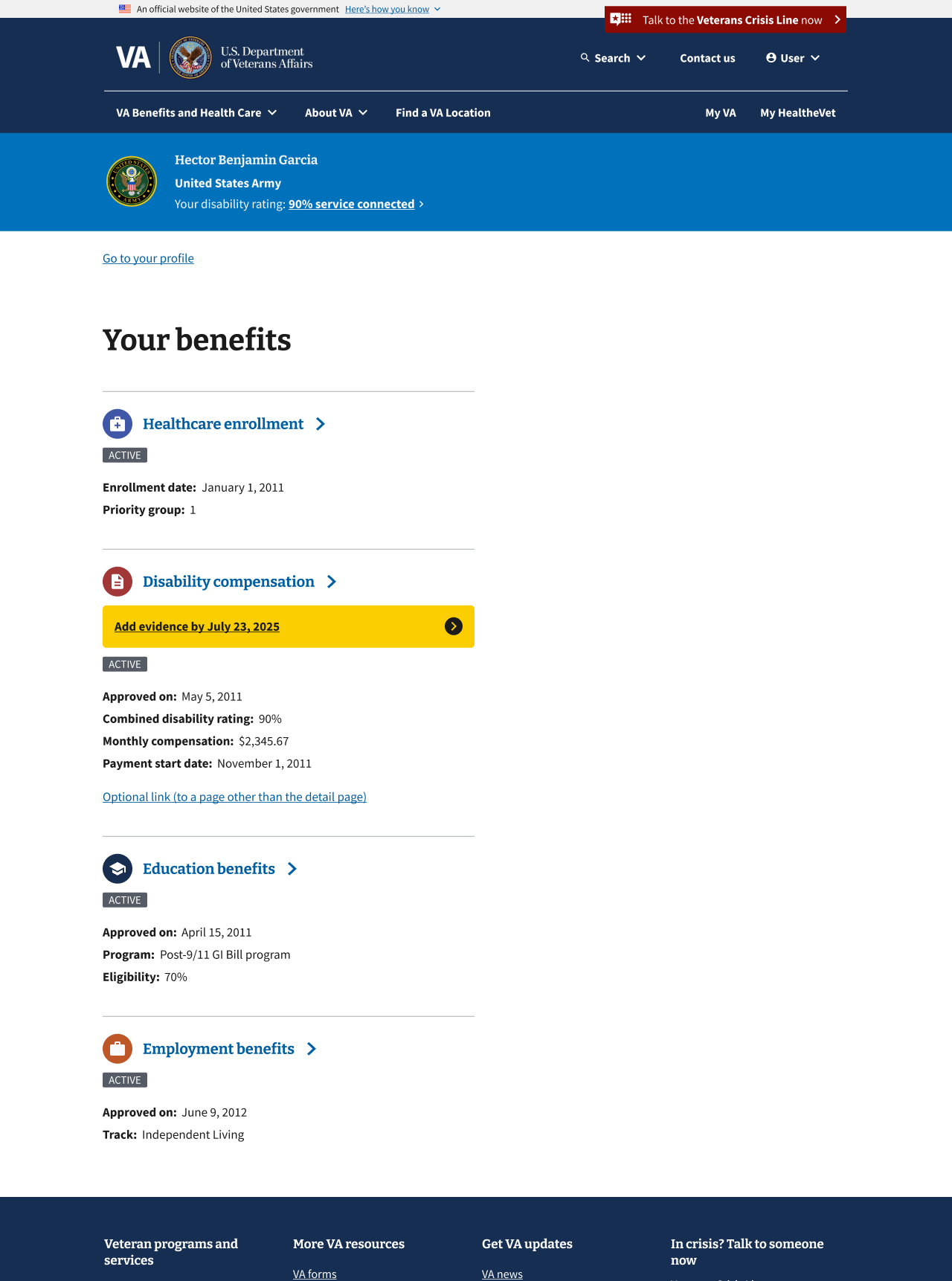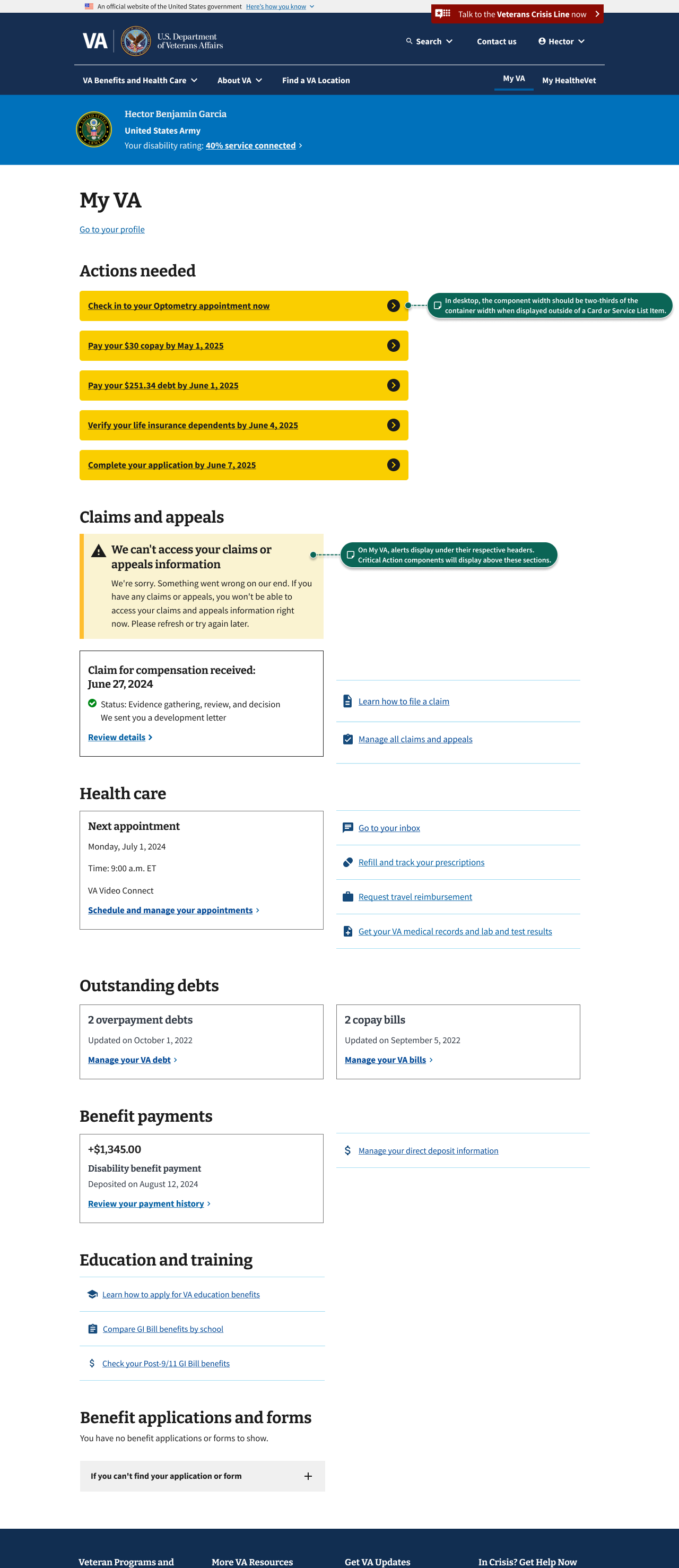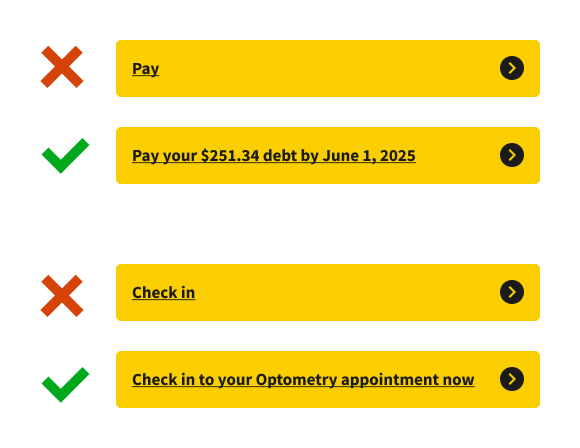Components
Critical Action
Use with caution: candidate- Contributors
- Lynn Stahl (Agile Six)
- Adam Whitlock (Ad Hoc)
- Belle Poopongpanit (Agile Six)
- Christine Rose Steiffer (Agile Six)
- Kristen Faiferlick (Ad Hoc)
Examples
View va-critical-action default in Storybook
View va-critical-action within a card component in Storybook
Usage
When to use Critical Action
- When you want to highlight a single task that will otherwise block the user from proceeding. Use the Critical Action component for important and time-sensitive tasks that prevent the user from accessing their VA benefits or VA services. For example, they might need to request a refill to continue using a specific prescription, check into an appointment, or pay an overdue debt to prevent VA from offsetting VA benefit payments.
When not to use Critical Action
- When an action is not urgent, time-sensitive, or required. Use the Alert component instead.
- When you need to alert the user about a system error. Use Alerts to express system errors.
- When you’re designing a form. Use the Alert component to display important messages in forms.
Anatomy or layout details

General guidance
- The Critical Action component links to a detail page from which the user can complete the call to action.
- The Critical Action component is not dismissible. It should be removed when the user completes the call to action.
Placement details
In most cases, display the Critical Action component in a Card or Service List Item component. Place the component directly below the Status tag and take up the width of the component it is nested within. Include only one Critical Action component in a Card or Service List Item. Do not include multiple Critical Action components in a single Card or Service List Item.

On the My VA page, you can stack Critical Action components at the top of the page. (Do not stack them within Cards or Service List Items.) The standalone component should take up 66% of the content width on larger screens, and expand to 100% of the width on mobile sized screens. When using it as a nested component, it should fill 100% of its parent component’s width. In the future, we’ll explore other placements of this component in other contexts. Currently, this component should not be stacked in any other context and should not appear outside of a container. Alerts have different guidelines and should not be stacked.

Code usage
Attributes and Properties
link
link
string
The link to a page where the user can take action
text
text
string
Text describing what critical action the user needs to take
Content considerations
- Use the sentence structure “[Verb] by [date by which user must take the action]”. For example, “Verify your life insurance dependents by June 4, 2025” or “Pay your $30 copay by May 1, 2025”.
- Keep the text concise. Work with the Platform Content team to develop clear, short messages that tell the user the required action and deadline (if applicable).
- Content should be a single sentence without a period. If the Platform Content team advises using two sentences, each sentence should end with a period.
- You may display the Critical Action component inside a Card or Service List Item on My VA or other page that show multiple VA benefits. In these cases, the component will be shown outside the context of a Card or Service List Item. It’s important that the content clearly communicates the action to the user. The examples below show appropriate levels of detail.

Accessibility considerations
- Critical Action always contains a link. Follow best practices for the Link and Link - Action components.
Related
Component checklist
Maturity
-
Guidance - Examples, usage, code usage, content considerations, and accessibility considerations are all complete.
-
Research - VFS team conducted research on this component which is linked from this page.
-
Stability - Component has been in production for more than 3 months with no significant issues found.
-
Adoption - Multiple teams have adopted this component.
Accessibility
While this component has been previously tested against older criteria, it has not yet been audited with the updated testing criteria.
Code assets
-
Variations - Storybook includes all variations (style, size, orientation, optional iconography, selection, error state, etc.)
-
Responsive - Component depicted in all responsive breakpoints.
-
Interactive states - Includes all interactive states that are applicable (hover, active, focus, keyboard focus, disabled).
-
Tokens - All design attributes (color, typography, layout, etc.) are available as tokens.
- Internationalization
- Describes i18n attributes.
Visual assets
-
Variations - Figma library includes all variations (style, size, orientation, optional iconography, selection, error state, etc.)
-
Responsive - Component designed to work in all responsive breakpoints.
-
Interactive states - Includes all interactive states that are applicable (hover, active, focus, keyboard focus, disabled).
-
Tokens - All design attributes (color, typography, layout, etc.) are available as tokens.
Legend:
-
Complete -
Incomplete -
Not applicable

 View va-critical-action default in Storybook
View va-critical-action default in Storybook